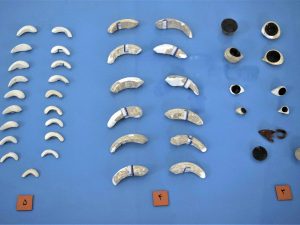Charkhāb, Borāzjānچرخاب، برازجان
Location: Charkhāb is the name of an Achaemenid palace in southern Iran, Bushehr Province.
29°15’27.44″N 51°11’19.75″E
Map
Historical Period
Achaemenid
History and description
Charkhāb is the name of an Achaemenid palace in the southwestern outskirts of the present-day town of Borāzjān. The monument at Charkhāb consists of a main hall with two rows of six bichrome column bases and an eastern portico with two rows of twelve bichrome column bases (figs. 1 and 2). Its plan resembles the Palace P in Pasargadae (fig. 3). All of the column bases and tori have been made of black and white stones (fig. 4) while those of the portico are probably made of white stone (fig. 5). No column shaft has so far been found. This is why the excavator believes that the building’s roof was supported by wooden columns. The absence of column shafts and superstructures suggests that the palace was never completed. There were four doorways in the columned hall. Scrolling volute ornaments the door socket of the eastern doorway, which is made of black stone (fig. 6). The building’s walls were made of mud-brick and measured 130 cm in thickness, with bricks measuring 33 x 33 x 10 cm and 32 x 32 x 6 cm. The excavator suggests that the construction of Charkhāb, which had begun in the latter part of Cyrus’ reign, was left unfinished. Ali Akbar Sarfarzaz, the excavator of the site, suggests that the columned hall at Charkhāb was probably ruined by torrential floods that are frequent in the region (fig. 7). Recent archaeological investigations at Charkhāb have shown that the expanse of the Achaemenid settlement goes beyond the columned hall.
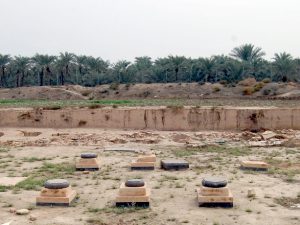
Fig. 1. The columned hall at Charkhāb (photo: A. Guraki)
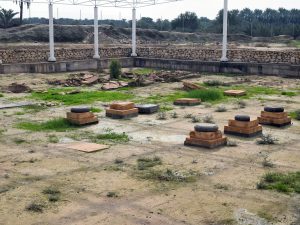
Fig. 2. The columned hall at Charkhāb with the protective roof (photo: Z. Zehbari)
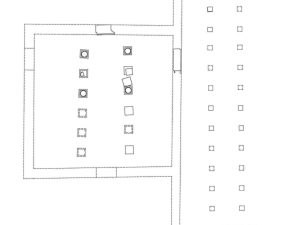
Fig. 3. Plan of the palatial building at Charkhāb (after Karimian, H., A. A. Sarfaraz, N. Ebrahimi, “Bāz-yābi-ye kākh-hā-ye hakhāmaneshi…”, p. 47)
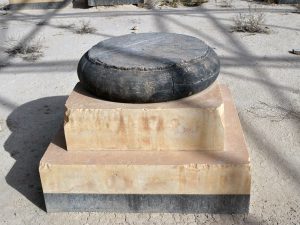
Fig 4. One of the bichrome bases belongs to the main hall of Charkhāb (Photo: Z. Zehbari).
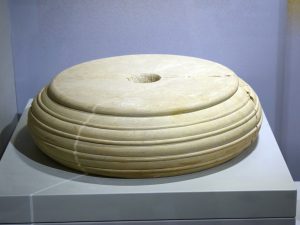
Fig. 5. Torus of the eastern portico of Charkhāb now in the Regional Museum of the Persian Gulf, Būshehr (Photo: Z. Zehbari).
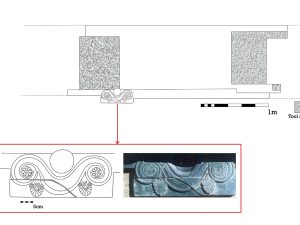
Fig. 6. The eastern doorway of Charkhāb with a decorated door socket (after Zehbari, “The Borazjan Monuments: A Synthesis of Past and Recent Works,” fig. 12)
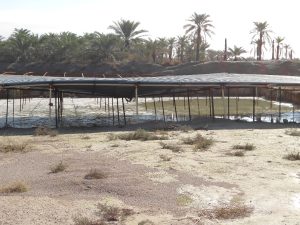
Fig. 7. Torrential rains flooding the columned hall at Charkhāb (photo: A. Guraki)
Archaeological Exploration
The ruins at Charkhāb emerged in 1971 when local workers were digging a water canal in the area. Ali Akbar Sarfaraz, who was excavating at Bishapur, was invited to explore the newly discovered ruins. Sarfaraz worked at Charkhāb for one season on behalf of the Iranian Center for Archaeological Research. Sarfaraz conducted a second season of excavation in 2001, and four uninterrupted seasons from 2004 to 2007. Later, in 2018, Nasrollah Ebrahimi and Kourosh Mohammadkhani conducted archaeological soundings and geophysical surveys at the site on behalf of the University of Tehran and the Shahid Beheshti University.
Finds
It has been reported that the site has yielded 188 Achaemenid artifacts, made of plaster, limestone, and smoothed stone. These include various parts of animal figures, such as eye stones, eyebrows, teeth, claws, and nails, as well as wings of birds, metal vases, and granite finds (fig. 8).
Bibliography
Ebrahimi, N., “Gozāresh-e kāvosh-hā-ye bāstānshenāsi-ye dar mohit-e peirāmuni-ye kākh-hā-ye hakhāmaneshi-ye Charkhāb, Sang-e Siāh va Bardak-e Siāh dar Borāzjān bar asās-e natāyej-e barresi-hā-ye geophizik”. Gozāresh-hā-ye hevdahomin gerdehamāee-ye sālāne-ye bāstānshenāsi-ye Irān, Vol. 17/1, R. Shirazi and Sh. Hurshid (eds.), Tehran, 1398/2019. pp. 30-37 (in Persian).
Henkelman W. F. M., “From Gabae to Taoce: The Geography of the Central Administrative Province”, P. Briant, W.F.M. Henkelman, M.W. Stolper (eds.), L’archive des Fortifications de Persépolis. État des questions et perspectives de recherches. Persika 12, Paris, 2008, pp. 303-316.
Henkelman W. F. M., “s.v. Tamukkan/ Taḫ(u)makka”, Reallexikon der Assyriologie, Vol 13, 2012, pp. 440–1.
Karimian, H., A. A. Sarfaraz, N. Ebrahimi, “Bāz-yābi-ye kākh-hā-ye hakhāmaneshi dar Borāzjān bā etekā be dāde-hā-ye bāstānshenāsi”, Bāgh-e Nazar, Vol. 14, 2010/1389, pp. 45-58 (in Persian).
Karimian, H., A. A. Sarfaraz, N. Ebrahimi, “Persian Splendour: Ancient palaces in Iran”. Current World Archaeology, vol. 49, 2011, pp. 42-49.
Sarfaraz, A., “Borazjan,” Survey of Excavations, Iran, vol. 11, 1973, pp. 188-189.
Zehbari, Z., “The Borazjan Monuments: A Synthesis of Past and Recent Works,” ARTA 2020.002. http://www.achemenet.com/pdf/arta/ARTA_2020_002_Zehbari.pdf
Zehbari, Z. “On the Participation of Egyptian Artists in Achaemenid Art”, in Bridging the Gap: Disciplines, Times, and spaces in Dialogue, Sessions 1, 2, and 5 from the Conference Broadening Horizons 6 Held at the Freie Universität Berlin, 24–28 June 2019, C. W. Hess and F. Manuelli (eds.), 2021, pp. 59- 79. https://www.archaeopress.com/Archaeopress/Products/9781803270944


